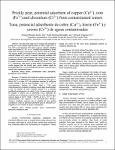Mostrar el registro sencillo del ítem
Prickly pear, potential adsorbent of copper (Cu2+), iron (Fe3+) and chromium (Cr3+) from contaminated waters [Tuna, potencial adsorbente de cobre (Cu2+), hierro (Fe3+) y cromo (Cr3+) de aguas contaminadas]
| dc.contributor.author | Morales-Aredo, Jhossep | |
| dc.contributor.author | Gamboa-Meregildo, Kedi | |
| dc.contributor.author | Vejarano, Ricardo | |
| dc.date.accessioned | 2021-06-17T21:04:19Z | |
| dc.date.available | 2021-06-17T21:04:19Z | |
| dc.date.issued | 2020-09-15 | |
| dc.identifier.citation | Morales, J., Gamboa, K. & Vejarano, R. (2020). Prickly pear, potential adsorbent of copper (Cu2+), iron (Fe3+) and chromium (Cr3+) from contaminated waters [Tuna, potencial adsorbente de cobre (Cu2+), hierro (Fe3+) y cromo (Cr3+) de aguas contaminadas]. Proceedings of the LACCEI International Multi-conference for Engineering, Education and Technology, (126). http://dx.doi.org/10.18687/LACCEI2020.1.1.126 | es_PE |
| dc.identifier.uri | https://hdl.handle.net/11537/26876 | |
| dc.description.abstract | ABSTRACT The aim of the study was to evaluate the potential of prickly pear cactus cladode (Opuntia ficus) to remove copper (Cu2+), iron (Fe3+) and chromium (Cr3+) from aqueous solutions. Distilled water mixed with Cu2+, Fe3+ or Cr3+ at initial concentrations of 19.60, 16.60 and 17.85 ppm, respectively, were used as media for testing. The aqueous media were treated with two adsorbents: i) a naturally collected cladode (CT), and ii) a cladode chemically modified with calcium (CTCa). The results indicate that a greater metal adsorption is obtained with the CTCa adsorbent. Moreover, 2 hours of contact is enough to remove up to 82.75, 78.36 and 87.84% of Cu2+, Fe3+ and Cr3+, respectively, with respect to their initial concentrations. Our results suggest that the prickly pear cactus cladode might be potentially effective as an eco-friendly adsorbent for removing heavy metals from contaminated waters. | es_PE |
| dc.description.abstract | RESUMEN El objetivo del estudio fue evaluar la capacidad del cladodio de tuna (Opuntia ficus) para la remoción de cobre (Cu2+), hierro (Fe3+) y cromo (Cr3+) de soluciones acuosas. Se utilizaron medios modelo a base de agua destilada, y Cu2+, Fe3+ o Cr3+ a concentraciones iniciales de 19.60, 16.60 y 17.85 ppm, respectivamente. Los medios se trataron con dos tipos de adsorbentes a base de cladodio de tuna: cladodio natural (CT), y cladodio modificado químicamente con calcio (CTCa). La mayor adsorción de los metales se obtuvo con el adsorbente CTCa, indicando los resultados que un tiempo de contacto de 2 horas sería suficiente para remover hasta el 82.75, 78.36 y 87.84% de Cu2+, Fe3+ y Cr3+, respectivamente, con respecto a sus concentraciones iniciales. Nuestros resultados sugieren que el cladodio de tuna podría considerarse como un potencial adsorbente para la remoción ecoamigable de estos metales de aguas contaminadas. | es_PE |
| dc.format | application/pdf | es_PE |
| dc.language.iso | spa | es_PE |
| dc.publisher | LACCEI | es_PE |
| dc.rights | info:eu-repo/semantics/openAccess | es_PE |
| dc.rights.uri | https://creativecommons.org/licenses/by-nc-sa/4.0/ | * |
| dc.source | Universidad Privada del Norte | es_PE |
| dc.source | Repositorio Institucional - UPN | es_PE |
| dc.subject | Frutas | es_PE |
| dc.subject | Adsorción | es_PE |
| dc.subject | Metales pesados | es_PE |
| dc.subject | Aguas residuales | es_PE |
| dc.title | Prickly pear, potential adsorbent of copper (Cu2+), iron (Fe3+) and chromium (Cr3+) from contaminated waters [Tuna, potencial adsorbente de cobre (Cu2+), hierro (Fe3+) y cromo (Cr3+) de aguas contaminadas] | es_PE |
| dc.type | info:eu-repo/semantics/conferenceObject | es_PE |
| dc.publisher.country | US | es_PE |
| dc.identifier.journal | Proceedings of the LACCEI International Multi-conference for Engineering, Education and Technology | es_PE |
| dc.description.peer-review | Revisión por pares | es_PE |
| dc.subject.ocde | https://purl.org/pe-repo/ocde/ford#2.11.00 | es_PE |
| dc.description.sede | Trujillo San Isidro | es_PE |
| dc.identifier.doi | http://dx.doi.org/10.18687/LACCEI2020.1.1.126 |







